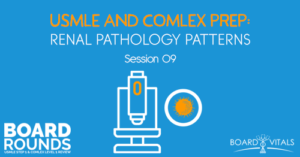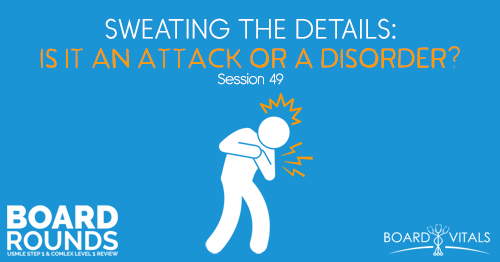Apple Podcasts | Google Podcasts

Session 09
In our renal question today we are asked to identify the pattern we would see on electron microscopy. See if you can find where the question leads you!
Once again, we’re joined by Dr. Andrea Paul from Board Vitals. If you’re getting ready to start preparing for your Step 1 or Level 1exam, check out Board Vitals and their QBank. Use the promo code BOARDROUNDS to save 15% off your QBank purchase. For more resources, be sure to check out all our other podcasts on the MedEd Media Network.
[02:50] A Challenging Area
Renal tends to come up in the top 3 of questions where people are going back because they answered them incorrectly or that they’re saving and redoing questions in this category. This indicates a level of less confidence or knowledge gap that needs to be filled for most students. Andrea thinks renal is a challenging area being a complicated system with a lot of memorization involved in the different syndromes. It’s a combination of genetics and pathophysiology and pathology. You’d have to be able to do everything from figuring out the disorder and knowing what it would look like on biopsy, looking at diagnostic studies and the physiology involved in the different renal disorders.
[04:22] Question
A 16-year-old boy presents. He recently immigrated from Russiam, has no major medical problems. He does mention he had an episode of light red urine three weeks ago. At the same time, he had a mild cold. He has no known allergies, no recent drug use or medications. His family has traced positive for kidney disease in his maternal uncle, but both of his parents are healthy. He also mentions that he has had lately noticed that he has mild hearing problem but he’s never thought much of that. It’s asking a kidney biopsy. This patient would most likely show which of the following:
(A) Linear pattern of IGG with fluorescent microscopy
(B) Splitting of the glomerular basement membrane
(C) Mesangial cell proliferation
(D) Epithelial humps or a thickened basement membrane that looks like a train track
[05:50] Finding the Diagnosis
The first thing to note here is the hearing loss, which is something that would lead you down a specific road. So we’re given a little hint here that can be very helpful. Based on history, the hearing loss would be due to Alport syndrome, which is a collage type 4 mutation resulting in abnormal basement membrane, that includes renal involvement, ocular involvement, and sensory neural hearing loss.
In this question, the answer you’d look at is the splitting of the glomerular basement membrane. The other way to describe this is the basket weave appearance, also known as the glomerular basement membrane lamellation, characterized by the layering and splitting of the membrane.
The key here is the Alport syndrome and remember what the findings would be and that specific disorder.
[08:30] Potential Questions
One possible question could be what other symptoms the patient may be experiencing. How is this commonly inherited because Alport syndrome can be inherited in a X-linked dominant way. You can also look through everything from genetics all the way through the pathology and electron microscopy for each disorder. Or maybe they won’t mention hearing loss but vision symptoms or inheritance pattern they’ve seen in the family, which they did when they mentioned the maternal uncle. So they’ve hinted this as well.
[09:50] What If There Was No Hint
If the question would have left the hearing loss out, they would probably mention a more extensive family history so you could see the inheritance pattern. They’re also mentioning hemoturia so you’re led to a nephrotic syndrome. That would also help. But they’d probably give you additional information to lead you down a more specific road for one of these different nephrotic causes.
[10:32] More Things to Know About Renal Stuff
You need to know the different patterns for each of the different nephrotic syndrome causes. This is part of the reason people redo these questions over and over. There’s a lot of memorization involved such as APGN and RPGN and what those look like, as well as microscopy. For this question, you would think through things like Goodpasture syndrome where you’d see a different pattern then you’d see that linear pattern which is that first option. And if it’s in older males then you’d have respiratory symptoms because there’s lung involvement. So you have to think through all the different associated organ systems with the different disorders and memorizing what the pattern looks like on each of them.
As far as symptoms, inheritance, and treatment, there are different diagnostic studies and treatments and those are the ones you can reason through based on the different disorders and what the physiologic effects of each is.
Lastly, keep in mind to know the demographics are. Some of them are more common in patients with specific histories, or ages or backgrounds – anything that can help you get to the answer more quickly will be helpful.
The immigration component must have been put in there too since there’s not a whole lot of medical history available. So they could actually put in things that could be helpful or completely just inserted for background information to make the case more robust, but not necessarily valuable.
It’s important to think through each piece of information in the question to make sure they tie together and you’d be able to eliminate something that clearly doesn’t help you. So you don’t focus too much on every specific part of the history.
[14:32] Board Vitals
Going over questions is the most beneficial thing you can do as a medical student preparing for your Step 1 or Level 1 exam. Check out Board Vitals for some help. They QBanks and over 1700 questions for Step 1 and almost as many for Level1. Have a free trial and check out their system to see if it works for you. Use the promo code BOARDROUNDS to save 15% off.
Links:
Board Vitals (promo code BOARDROUNDS)
SEARCH SITE
LISTEN FOR FREE











